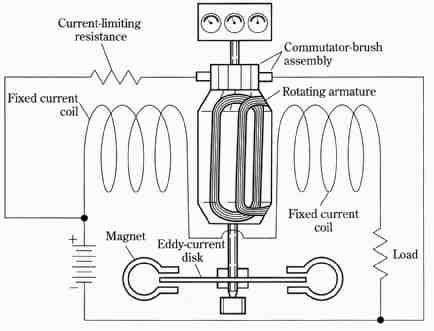AMAZON multi-meters discounts AMAZON oscilloscope discounts
..An example of motor action obtained with the use of air-core solenoids, or coils, is the electrodynamometer-type wattmeter illustrated in FIG. 14. In the arrangement shown, the moving coil carries a current proportional to the voltage of the power source (or very nearly to the voltage impressed across the load). This coil consists of many turns of fine wire with a current-limiting resistance generally inserted in series with it. The two stationary coils are connected in series-aiding and also in series with the load. These coils comprise relatively few turns of heavy-gauge wire. The moving coil experiences a torque closely proportional to the product of the voltage across the moving coil and the current through the stationary coils, thereby producing a deflection determined by the product E x I, or watts. Because the angle of the interacting fluxes changes with the physical rotation of the moving coil, a slightly nonlinear scale is necessary. (Not shown are spiral countertorque springs, which tend to restore the moving coil-pointer system to zero.)
The test functions of this device are not of direct interest to us, but it is quite clear that motor action is achieved. To be sure, the rotation is limited to a small arc, rather than being continuous. But, the extension of this operation to continuous rotation should not require a high degree of inventiveness. It is also apparent that this type of motor action should be obtainable from an ac source as well as from a dc source. This is because the magnetic-field directions of the moving coil and of the stationary coils both change together. Therefore, the torque developed remains unidirectional. Indeed, such a wattmeter can be used in both dc and ac circuits.

FIG. 14 The electrodynamometer-type wattmeter.

FIG. 15 The commutator-type watt-hour meter.
The commutator-type dc watt-hour meter of FIG. 15 is the logical extension of the wattmeter just discussed. Here, is our first true motor, inasmuch as continuous rotation is obtained. The shaft of this motor drives a mechanical readout. In turn, the rotation of the shaft is restrained by countertorque developed in the eddy-current disk. However, these shaft-attached devices relate most relevantly to the instrumental purposes of this “motor.” From the standpoint of continuous rotation, the significant component is the commutator and brush assembly. In simplest terms, this item is a rotary switch that automatically reverses current flow in the armature so that a unidirectional torque, rather than a “hangup,” is developed. And because the commutator is mounted directly on the shaft, the current-reversing switching cycles are synchronized with the turning of the armature coils.